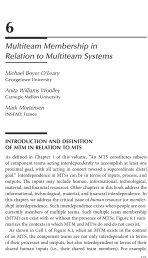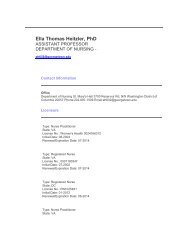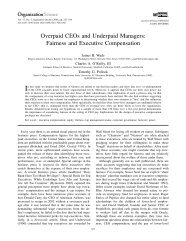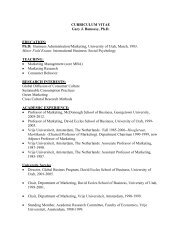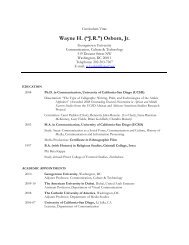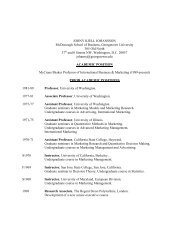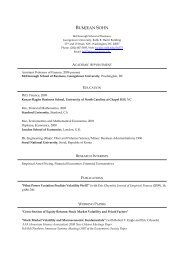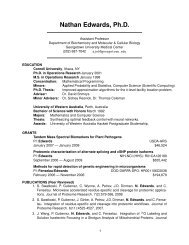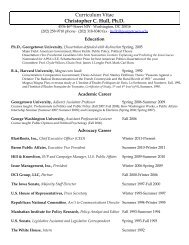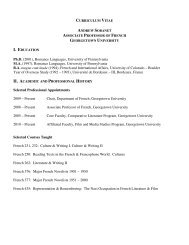Using job embeddedness factors to explain voluntary turnover in ...
Using job embeddedness factors to explain voluntary turnover in ...
Using job embeddedness factors to explain voluntary turnover in ...
You also want an ePaper? Increase the reach of your titles
YUMPU automatically turns print PDFs into web optimized ePapers that Google loves.
RIJH 329649—8/8/2008—MADHAVANS—305665———Style 212345678910111213141516171819202122232425262728293031323334353637383940414243444546474849The International Journal of Human Resource Management,Vol. 19, No. 9, September 2008, 1553–1568<strong>Us<strong>in</strong>g</strong> <strong>job</strong> <strong>embeddedness</strong> <strong>fac<strong>to</strong>rs</strong> <strong>to</strong> <strong>expla<strong>in</strong></strong> <strong>voluntary</strong> <strong>turnover</strong><strong>in</strong> four European countriesCem Tanova a * and Brooks C. Hol<strong>to</strong>m ba Faculty of Bus<strong>in</strong>ess and Economics, Eastern Mediterranean University, Gazimagusa, North Cyprus viaMers<strong>in</strong> 10; b McDonough School of Bus<strong>in</strong>ess, George<strong>to</strong>wn University, Wash<strong>in</strong>g<strong>to</strong>n, DC 20057, USAThe ag<strong>in</strong>g of the European workforce coupled with exist<strong>in</strong>g deficits of skilled workers <strong>in</strong> vitalsec<strong>to</strong>rs (e.g., <strong>in</strong>formation and communication technology) make the attraction and retention ofskilled workers a critical strategic human resource management issue. The large-scale,multi-country study reported <strong>in</strong> this article <strong>in</strong>vestigates the causes of <strong>voluntary</strong> <strong>turnover</strong>.The study is based on a large European dataset that conta<strong>in</strong>s <strong>in</strong>formation about a wide varietyof variables that have been shown <strong>to</strong> <strong>in</strong>fluence <strong>voluntary</strong> <strong>turnover</strong>. The results <strong>in</strong>dicate that thetraditional <strong>turnover</strong> model, where ease of movement and desirability of movement areregarded as important predic<strong>to</strong>rs of <strong>turnover</strong>, receives support. Importantly, the study alsoshows that a new theory of employee retention – <strong>job</strong> <strong>embeddedness</strong> – <strong>expla<strong>in</strong></strong>s a significantamount of variance above and beyond the role of demographic and traditional variables.In sum, the evidence suggests that the <strong>turnover</strong> decision is not only about the <strong>in</strong>dividual’sattitudes <strong>to</strong>wards work or about the actual opportunities <strong>in</strong> the labour market, but also <strong>job</strong><strong>embeddedness</strong>.Keywords: <strong>job</strong> <strong>embeddedness</strong>; <strong>voluntary</strong> <strong>turnover</strong>; ease of movement; desire of movementIntroductionThe attraction, development and retention of skilled employees are critical issues fororganizations and nations. While enlargement of the European Union and <strong>in</strong>tensified European<strong>in</strong>tegration have <strong>in</strong>troduced the possibility of greater labour mobility, there cont<strong>in</strong>ue <strong>to</strong> bemarked differences between the EU and United States. Data from Eurostat <strong>in</strong>dicate that <strong>in</strong> agiven year approximately 1% of the EU population changes region, compared with nearly 6%who moved from one county <strong>to</strong> another <strong>in</strong> the United States (Fuller 2002). The same datasetshows that Europeans are half as likely <strong>to</strong> change <strong>job</strong>s as Americans <strong>in</strong> a given year. Given thesedifferences between Europe and the United States and the fact that the vast majority of academicresearch on <strong>voluntary</strong> <strong>turnover</strong> has been published us<strong>in</strong>g models and samples from theUnited States, there is an urgent need <strong>to</strong> rigorously test the generalizability of these models <strong>in</strong> theEuropean context.From the perspective of the organization, employee <strong>turnover</strong> creates both tangible and<strong>in</strong>tangible costs. The tangible costs <strong>in</strong>clude recruitment, selection, tra<strong>in</strong><strong>in</strong>g, adjustment time,possible product and/or service quality problems, and the costs of agency workers/temporarystaff (Morrell, Loan-Clarke and Wilk<strong>in</strong>son 2004a). The <strong>in</strong>tangible costs, which may be evenmore significant than the tangibles, <strong>in</strong>volve the effect of <strong>turnover</strong> on organizational culture,employee morale, social capital and organizational memory (Morrell et al. 2004a).*Correspond<strong>in</strong>g author. Email: cem.tanova@emu.edu.trISSN 0958-5192 pr<strong>in</strong>t/ISSN 1466-4399 onl<strong>in</strong>eq 2008 Taylor & FrancisDOI: 10.1080/09585190802294820http://www.<strong>in</strong>formaworld.com
RIJH 329649—8/8/2008—MADHAVANS—305665———Style 21554C. Tanova and B.C. Hol<strong>to</strong>m50515253545556575859606162636465666768697071727374757677787980818283848586878889909192939495969798At the national level, some labour mobility is viewed as positive for national economiesbecause of <strong>job</strong> mismatches (Jovanovic 1979). Some employees may have accepted a <strong>job</strong> that wasbelow their abilities <strong>in</strong> difficult times and they may wish <strong>to</strong> switch when they f<strong>in</strong>d theopportunity. Or some organizations may have employed an <strong>in</strong>dividual who was not a goodmatch for the position. Jovanovic (1979) views <strong>job</strong>s as ‘experience goods’ and as ‘search goods’.Based on the <strong>job</strong> employee match<strong>in</strong>g model, workers move across <strong>job</strong>s <strong>in</strong> order <strong>to</strong> f<strong>in</strong>d a goodmatch which pays for their aptitudes and meets their expectations (Davia 2005).For an <strong>in</strong>dividual, <strong>turnover</strong> (<strong>in</strong>clud<strong>in</strong>g both <strong>voluntary</strong> and <strong>in</strong><strong>voluntary</strong>) will mean mak<strong>in</strong>g abreak with exist<strong>in</strong>g social networks, the stress of a new environment and an adjustment process.For some employees there may be direct losses related <strong>to</strong> benefits that they were receiv<strong>in</strong>g asbe<strong>in</strong>g part of the organization (Griffeth, Hom and Gaertner 2000). There may also be someadvantages. For example, Davia (2005) reports that employees at the early stages of their careerwho voluntarily leave, experience positive <strong>in</strong>creases <strong>in</strong> their wages compared <strong>to</strong> those that do notchange <strong>job</strong>s. Furthermore, Davia (2005) found that <strong>turnover</strong> may pay <strong>in</strong> the mid-term even for<strong>in</strong><strong>voluntary</strong> movers although at a decreas<strong>in</strong>g rate.One reason that a high rate of <strong>voluntary</strong> <strong>turnover</strong> is alarm<strong>in</strong>g for many managers is the fearthat the employees with better skills and abilities will be those who are able <strong>to</strong> leave whereasthose who rema<strong>in</strong> will be those who cannot f<strong>in</strong>d other <strong>job</strong>s. Thus, while <strong>voluntary</strong> <strong>turnover</strong> maybe beneficial <strong>to</strong> the employee, it may not be for the organization. Though additional <strong>fac<strong>to</strong>rs</strong>beyond <strong>in</strong>dividual preferences come <strong>in</strong><strong>to</strong> play especially <strong>in</strong> the European context (e.g., there aremany other issues that prevent employees from leav<strong>in</strong>g other than not f<strong>in</strong>d<strong>in</strong>g alternative <strong>job</strong>s),this <strong>to</strong>pic merits rigorous scientific attention because of the significant consequences at the<strong>in</strong>dividual, organizational and national levels.Not surpris<strong>in</strong>gly, <strong>turnover</strong> cont<strong>in</strong>ues <strong>to</strong> be a <strong>to</strong>pic of <strong>in</strong>terest among researchers fromdiscipl<strong>in</strong>es such as management, psychology, economics and sociology. Shaw, Delery, Jenk<strong>in</strong>sand Gupta (1998) report over 1,500 studies on the subject. There have also been several metaanalyseson the determ<strong>in</strong>ants of <strong>turnover</strong> (Cot<strong>to</strong>n and Tuttle 1986; Cohen 1993; Hom andGriffeth 1995; Griffeth et al. 2000). Yet, there still is no universal agreement on the <strong>fac<strong>to</strong>rs</strong> that<strong>expla<strong>in</strong></strong> why some employees leave and some stay. Simple logic suggests that assum<strong>in</strong>gemployees have viable <strong>job</strong> alternatives, if they are satisfied with their current <strong>job</strong> they will stay,but if they aren’t they will leave (Mitchell, Hol<strong>to</strong>m, Lee, Sablynski and Erez 2001). However,scientific literature shows that work attitudes (like <strong>job</strong> satisfaction) play only a relatively smallrole overall <strong>in</strong> <strong>turnover</strong> (Hom and Griffeth 1995; Griffeth et al. 2000). After a comprehensivereview of the <strong>turnover</strong> literature Morrell, Loan-Clarke, and Wilk<strong>in</strong>son (2001) conclude that thereis need for new theory <strong>in</strong> the study of <strong>turnover</strong>. The purpose of this article is <strong>to</strong> test a relativelynew theory of employee retention (<strong>job</strong> <strong>embeddedness</strong>) developed and tested <strong>in</strong> the United States<strong>to</strong> assess its generalizability <strong>in</strong> the European context.Turnover modelsMuch of the current theoretical and empirical work on the <strong>to</strong>pic of <strong>turnover</strong> is based on Marchand Simon’s (1958) foundation. They emphasized that employees’ degree of perceived ease ofmovement and perceived desirability of movement determ<strong>in</strong>es their likelihood of seek<strong>in</strong>g a new<strong>job</strong>. The desirability of movement depends on <strong>job</strong>-related attitudes and <strong>in</strong>ternal opportunitieswhile ease of movement depends on external <strong>fac<strong>to</strong>rs</strong> such as availability of alternative <strong>job</strong>s andunemployment levels.It is possible <strong>to</strong> dist<strong>in</strong>guish <strong>turnover</strong> models as be<strong>in</strong>g from either the ‘psychological school’or ‘labour market school’ (Morrell et al. 2001). The labour market school focuses on employeesas rational, homogeneous and equally affected by external <strong>fac<strong>to</strong>rs</strong>. The emphasis may
RIJH 329649—8/8/2008—MADHAVANS—305665———Style 2The International Journal of Human Resource Management 155599100101102103104105106107108109110111112113114115116117118119120121122123124125126127128129130131132133134135136137138139140141142143144145146147be <strong>in</strong>terpreted as determ<strong>in</strong>istic s<strong>in</strong>ce external <strong>in</strong>fluences are seen <strong>to</strong> determ<strong>in</strong>e actions (Morrellet al. 2004a). The <strong>to</strong>pics discussed <strong>in</strong>clude <strong>job</strong> search (Fahr and Schneider 2004; Mano-Negr<strong>in</strong>and Tzafrir 2004), labour market flexibility, <strong>job</strong> mobility and wage mobility (Royalty 1998;Davia 2005), unemployment level (Trevor 2001) and person-<strong>job</strong> match<strong>in</strong>g (Jovanovic 1979).The psychological school focuses on <strong>to</strong>pics related <strong>to</strong> <strong>expla<strong>in</strong></strong><strong>in</strong>g or predict<strong>in</strong>g leavers’behaviour. The emphasis can be <strong>in</strong>terpreted as <strong>voluntary</strong>, s<strong>in</strong>ce <strong>in</strong>dividual choice is emphasized(Morrell et al. 2004a). The <strong>to</strong>pics discussed are <strong>in</strong>dividual characteristics, stress, burnout,emotional exhaustion, personality, <strong>job</strong> satisfaction, organizational commitment, and <strong>job</strong><strong>in</strong>volvement (Hom and K<strong>in</strong>icki 2001).Further, a general withdrawal construct has been proposed whereby <strong>in</strong>dividuals engage <strong>in</strong>activities (e.g., lateness, absenteeism, dim<strong>in</strong>ished performance) that are seen as lead<strong>in</strong>g<strong>in</strong>dica<strong>to</strong>rs of <strong>turnover</strong> (Hul<strong>in</strong> 1991; Sablynski, Mitchell, Lee, Bur<strong>to</strong>n and Hol<strong>to</strong>m 2002). Morerecently the image theory of decision mak<strong>in</strong>g has been <strong>in</strong>tegrated with the unfold<strong>in</strong>g model of<strong>turnover</strong> (Lee and Mitchell 1994; Morrell et al. 2004a; Morrell, Loan-Clarke and Wilk<strong>in</strong>son2004b). This approach demonstrates that for many the decision <strong>to</strong> leave is not the result ofgradual built up of negative attitudes but rather the result of a shock, or some event that issignificant enough <strong>to</strong> overcome the exist<strong>in</strong>g <strong>in</strong>ertia.A new construct, <strong>job</strong> <strong>embeddedness</strong>, is conceptualized as <strong>in</strong>fluenc<strong>in</strong>g the decision <strong>to</strong> rema<strong>in</strong>through the level of l<strong>in</strong>ks a person has <strong>to</strong> other people or activities, the extent that the person’s<strong>job</strong> and community are congruent with the other aspects of their life, and the sacrifices a personwould make <strong>in</strong> the process of leav<strong>in</strong>g their employment (Mitchell et al. 2001). The well-knownwork of Granovetter (1985) <strong>in</strong>troduced ‘<strong>embeddedness</strong>’ as a way <strong>to</strong> <strong>expla<strong>in</strong></strong> how socialrelations <strong>in</strong>fluence economic action. Build<strong>in</strong>g on this idea, the ‘<strong>job</strong> <strong>embeddedness</strong>’ (Mitchellet al. 2001) construct views the <strong>in</strong>dividual as a part of a complex web of relationships andattachments. The more extensive the web is, the more l<strong>in</strong>es that connect the many aspects ofthe <strong>in</strong>dividual’s life. Thus, the more elaborate web will have a stronger <strong>in</strong>fluence on an<strong>in</strong>dividual who is consider<strong>in</strong>g mak<strong>in</strong>g changes <strong>in</strong> one part of the web because that change willaffect many other features of the <strong>in</strong>dividual’s life (Hol<strong>to</strong>m, Mitchell, and Lee, forthcom<strong>in</strong>g).The critical aspects of <strong>job</strong> <strong>embeddedness</strong> are: 1) the l<strong>in</strong>ks that people have on and off the <strong>job</strong>;2) the fit that they perceive between their self-concept and the environment that they live andwork <strong>in</strong>; and 3) the sacrifices that they would make <strong>in</strong> giv<strong>in</strong>g up their <strong>job</strong> <strong>in</strong> terms of how thisaction would affect the other aspects of their life. L<strong>in</strong>ks, fit and sacrifice all have on-the-<strong>job</strong> andoff-the-<strong>job</strong> dimensions.L<strong>in</strong>ks <strong>to</strong> the organization are the relationships that the <strong>in</strong>dividual has with the organization(e.g., department, work team) and the relationships that they have with others at work (e.g.,coworkers, boss, men<strong>to</strong>r). The l<strong>in</strong>ks <strong>to</strong> the community <strong>in</strong>clude the ties that the <strong>in</strong>dividual has <strong>in</strong>the area especially with friends, relatives and organizations. Fit with the organization assesseshow the <strong>in</strong>dividual perceives their work <strong>in</strong> the organization and whether the <strong>in</strong>dividual feels thatthere is congruence between what she wants <strong>to</strong> do or can do and what she is actually do<strong>in</strong>g. Fitwith the community is the perception of fit between the <strong>in</strong>dividual’s concepts of the communitythat they would like <strong>to</strong> be a part of and the community that they actually live <strong>in</strong>. This <strong>in</strong>cludes thevalues of the community as well as the physical offer<strong>in</strong>gs such as hous<strong>in</strong>g and leisure activities.The sacrifice associated with leav<strong>in</strong>g a <strong>job</strong> focuses primarily on the tangible losses that would be<strong>in</strong>curred if the <strong>in</strong>dividual left the <strong>job</strong> (e.g., benefits). Also, the community sacrifice dimensioncaptures tangible losses <strong>in</strong>volved if the employee was contemplat<strong>in</strong>g leav<strong>in</strong>g the communitybecause she was leav<strong>in</strong>g the organization.Mitchell et al. (2001) conceive <strong>job</strong> <strong>embeddedness</strong> as a mediat<strong>in</strong>g construct between an<strong>in</strong>dividual’s work and personal life. Each dimension may have different degrees of importancefor different <strong>in</strong>dividuals at different times or stages of their lives, however the magnitude of <strong>to</strong>tal
RIJH 329649—8/8/2008—MADHAVANS—305665———Style 21556C. Tanova and B.C. Hol<strong>to</strong>m148149150151152153154155156157158159160161162163164165166167168169170171172173174175176177178179180181182183184185186187188189190191192193194195196embedd<strong>in</strong>g forces will have an <strong>in</strong>fluence on a person’s decision <strong>to</strong> leave. In 2001, Mitchell et al.produced evidence that <strong>job</strong> <strong>embeddedness</strong> predicts employee <strong>turnover</strong> over and above theeffects of gender, psychological <strong>fac<strong>to</strong>rs</strong> (e.g., <strong>job</strong> satisfaction), and labour market <strong>fac<strong>to</strong>rs</strong>(e.g., <strong>job</strong> search behaviours). Further evidence of the predictive power of <strong>job</strong> <strong>embeddedness</strong> waspresented <strong>in</strong> 2004 by Lee, Mitchell, Sablynski, Bur<strong>to</strong>n, and Hol<strong>to</strong>m. In a large multi-nationalbank they found that <strong>job</strong> <strong>embeddedness</strong> not only predicts who leaves but also predicts <strong>in</strong>-roleperformance as well as extra-role performance. Additionally, Mallol, Hol<strong>to</strong>m, and Lee(forthcom<strong>in</strong>g) found that though levels of <strong>job</strong> <strong>embeddedness</strong> varied systematically between USborn and non-US born employees (pre-dom<strong>in</strong>antly Hispanic), the overall construct predicted<strong>voluntary</strong> <strong>turnover</strong> for both groups.The current article proposes a model that <strong>in</strong>corporates both the ease and desirability ofmovement variables <strong>to</strong>gether with <strong>job</strong> <strong>embeddedness</strong> <strong>fac<strong>to</strong>rs</strong> <strong>to</strong> understand <strong>turnover</strong> us<strong>in</strong>g theavailable data from European Community Household Panel survey.Expected relationshipsPersonal characteristicsAgeYounger employees are more likely <strong>to</strong> take risks at the beg<strong>in</strong>n<strong>in</strong>g of their careers. They are alsomore likely <strong>to</strong> accept positions that are below their abilities and expectations at the beg<strong>in</strong>n<strong>in</strong>g oftheir career and move on <strong>to</strong> better <strong>job</strong>s when those <strong>job</strong>s become available. Meta-analyticresearch supports the negative age-<strong>turnover</strong> relationship (Griffeth et al. 2000).GenderFemale workers traditionally have been seen as hav<strong>in</strong>g a lower attachment <strong>to</strong> the labour forcethan men. However, <strong>in</strong> their meta-analysis, Griffeth et al. (2000) show only a negligibledifference between men and women <strong>in</strong> terms of <strong>turnover</strong> (women are slightly more likely <strong>to</strong>leave their <strong>job</strong>s than men). Further, Royalty (1998) found gender differences <strong>in</strong> <strong>turnover</strong> are due<strong>to</strong> the behaviour of less educated women (many of whom leave the labour force when they leavea <strong>job</strong>). In sum, educated women and men are very similar <strong>in</strong> their <strong>turnover</strong> behaviour.IncomeAs a person’s <strong>in</strong>come from a <strong>job</strong> <strong>in</strong>creases, the probability of their leav<strong>in</strong>g the <strong>job</strong> decreases.This result has been demonstrated <strong>in</strong> diverse occupations, demographic groups, and acrossgender. Though the effect is typically modest (e.g., r ¼ 2.11; Griffeth et al. 2000), it ispersistent.Hypothesis 1: Age and <strong>in</strong>come will be negatively related <strong>to</strong> <strong>voluntary</strong> <strong>turnover</strong>.Desirability of movementJob satisfactionJob satisfaction has been found across many studies <strong>to</strong> be a reliable predic<strong>to</strong>r of <strong>turnover</strong>, thoughthe amount of variance <strong>expla<strong>in</strong></strong>ed is typically modest (Griffeth et al. 2000). Van Breukelen, vander Vlist and Steensma (2004) also show a negative relationship between <strong>job</strong> attitudes and<strong>turnover</strong>. Measur<strong>in</strong>g <strong>job</strong> satisfaction at two different times before the measurement of leav<strong>in</strong>g orstay<strong>in</strong>g, they f<strong>in</strong>d that there was stability <strong>in</strong> employees’ attitudes. However, they report that after
RIJH 329649—8/8/2008—MADHAVANS—305665———Style 2The International Journal of Human Resource Management 1557197198199200201202203204205206207208209210211212213214215216217218219220221222223224225226227228229230231232233234235236237238239240241242243244245the variance <strong>expla<strong>in</strong></strong>ed by <strong>in</strong>tentions <strong>to</strong> leave the other variables did not <strong>expla<strong>in</strong></strong> much. Trevor(2001) analyzed <strong>in</strong>teractions between actual ease of movement determ<strong>in</strong>ants such as educationlevel and market conditions and found that when unemployment rates were low <strong>job</strong> satisfactionhad greater impact on <strong>turnover</strong> decisions. Moreover, he found the effects of <strong>job</strong> satisfaction andunemployment rate depended upon levels of education, cognitive ability and occupation-specifictra<strong>in</strong><strong>in</strong>g.Ease of movementUnemployment levelArmknecht and Early (1972) found that up <strong>to</strong> 78% of the variance <strong>in</strong> aggregate quit rate could be<strong>expla<strong>in</strong></strong>ed on the basis of present and expected economic conditions. Clearly, labour marketsshape the quality and quantity of alternative opportunities (Mano-Negr<strong>in</strong> and Tzafrir 2004) and,thus, an <strong>in</strong>dividual’s behaviour or even attitudes are likely <strong>to</strong> be different <strong>in</strong> times of high versuslow unemployment (Trevor 2001).EducationHigher levels of education are likely <strong>to</strong> <strong>in</strong>crease an <strong>in</strong>dividual’s <strong>turnover</strong> likelihood by<strong>in</strong>creas<strong>in</strong>g his or her opportunities. Moreover, an unobservable characteristic that could beassociated with higher levels of education may be labelled ‘career m<strong>in</strong>dedness’ (Royalty 1998).A career-m<strong>in</strong>ded <strong>in</strong>dividual would be more likely <strong>to</strong> take the risk of chang<strong>in</strong>g a <strong>job</strong> for potentialimprovements <strong>in</strong> their career.Withdrawal behavioursWithdrawalAccord<strong>in</strong>g <strong>to</strong> Hul<strong>in</strong> (1991), <strong>in</strong>dividuals are likely <strong>to</strong> progressively enact more extrememanifestations of <strong>job</strong> withdrawal. This could beg<strong>in</strong> with putt<strong>in</strong>g less physical and mental energy<strong>to</strong> their <strong>job</strong>, or go<strong>in</strong>g <strong>to</strong> work late and lead <strong>to</strong> absenteeism and eventually reach<strong>in</strong>g <strong>voluntary</strong><strong>turnover</strong>. With regard <strong>to</strong> behavioural predic<strong>to</strong>rs, the literature shows a small, positiverelationship between <strong>job</strong> withdrawal behaviour such as tard<strong>in</strong>ess or absenteeism and <strong>turnover</strong>(Griffeth et al. 2000).Job searchAnother sign of possible withdrawal occurs when <strong>in</strong>dividuals start look<strong>in</strong>g for other <strong>job</strong>s.The <strong>turnover</strong> literature shows a strong, positive relationship between actual <strong>job</strong> searchbehaviours and <strong>turnover</strong> (Griffeth et al. 2000).Hypothesis 2: Desirability and ease of movement <strong>fac<strong>to</strong>rs</strong> as well as withdrawal behaviours willpredict variance <strong>in</strong> <strong>turnover</strong> beyond that <strong>expla<strong>in</strong></strong>ed by demographic variables and<strong>in</strong>come.Job <strong>embeddedness</strong>Q1 As discussed previously, <strong>job</strong> <strong>embeddedness</strong> has <strong>expla<strong>in</strong></strong>ed variance <strong>in</strong> <strong>voluntary</strong> <strong>turnover</strong> aboveand beyond gender, desirability and ease of movement variables as well as <strong>job</strong> search behaviours(Mitchell et al. 2001). In that study and subsequently (Lee et al. 2004), <strong>job</strong> <strong>embeddedness</strong> hasbeen operationalized as the comb<strong>in</strong>ation of six <strong>fac<strong>to</strong>rs</strong>: an employee’s fit with the community, fit
RIJH 329649—8/8/2008—MADHAVANS—305665———Style 21558C. Tanova and B.C. Hol<strong>to</strong>m246247248249250251252253254255256257258259260261262263264265266267268269270271272273274275276277278279280281282283284285286287288289290291292293294with the organization, l<strong>in</strong>ks with the community, l<strong>in</strong>ks with the organization, sacrifice of leav<strong>in</strong>gthe community and sacrifice of leav<strong>in</strong>g the organization. Put differently, an <strong>in</strong>dividual who hasstrong l<strong>in</strong>ks <strong>to</strong> the community and the organization, who perceives that there is a good fitbetween her expectations and what the community and the organization is currently provid<strong>in</strong>g,and stands much <strong>to</strong> lose if these l<strong>in</strong>ks are broken will be less likely <strong>to</strong> change <strong>job</strong>s than a personwho is less ‘embedded’.Hypothesis 3: Job <strong>embeddedness</strong> <strong>fac<strong>to</strong>rs</strong> will improve the prediction of <strong>turnover</strong> beyonddemographic <strong>fac<strong>to</strong>rs</strong>, <strong>in</strong>come, desirability and ease of movement and withdrawalbehaviours.MethodDataThe European Community Household Panel (ECHP) survey is a harmonized, cross nationalannual longitud<strong>in</strong>al survey that focuses on household <strong>in</strong>come and liv<strong>in</strong>g conditions and provides<strong>in</strong>formation on employment and personal demographic characteristics. It has been collecteds<strong>in</strong>ce 1994 under Eurostat coord<strong>in</strong>ation. In the first wave approximately 130,000 adults aged 16years and over were <strong>in</strong>terviewed <strong>in</strong> about 60,500 nationally represented households <strong>in</strong> the then12 member states. However not all countries entered the survey at the same time and forGermany, Luxembourg and United K<strong>in</strong>gdom the orig<strong>in</strong>al sample has been replaced withharmonized versions of household panels already be<strong>in</strong>g produced nationally. For researchers afurther anonimized sub-sample of the orig<strong>in</strong>al data is available under strict contractualconditions. Further <strong>in</strong>formation on the ECHP and discussion on attrition, non-response, andweigh<strong>in</strong>g procedures can be found <strong>in</strong> Peracchi (2002). Some of the variables do not haveidentical response sets for some countries which limit the analysis that can be carried out us<strong>in</strong>gthose variables. For example, the education level for the Netherlands seems <strong>to</strong> have beendifferent after the third wave (i.e., some respondents who had higher levels of educationwere reported <strong>to</strong> have miss<strong>in</strong>g data or lower education levels <strong>in</strong> subsequent waves).Luxemburg, Ireland, Greece, Portugal, Austria, Sweden and The United K<strong>in</strong>gdom had manymiss<strong>in</strong>g data for variables of <strong>in</strong>terest <strong>in</strong> the current study and the question regard<strong>in</strong>g reason forleav<strong>in</strong>g the previous <strong>job</strong> <strong>in</strong> Germany <strong>in</strong>dicated that there was a different set of responses used <strong>in</strong>this country <strong>in</strong> the recent waves of the survey, hence these countries were not <strong>in</strong>cluded <strong>in</strong> theanalysis. That allowed us <strong>to</strong> proceed with four European countries: Denmark, Italy, Spa<strong>in</strong>, andF<strong>in</strong>land.<strong>Us<strong>in</strong>g</strong> the data for years 2000 and 2001 – the most recent waves – from the ECHP, weidentified the <strong>in</strong>dividuals that had a full-time <strong>job</strong> (work<strong>in</strong>g at least 30 hours per week) otherthan self-employment <strong>in</strong> the year 2000 who were between the ages of 20–59. The age and thework<strong>in</strong>g hour limitations were used <strong>in</strong> order <strong>to</strong> focus on <strong>in</strong>dividuals who had a relativelystronger attachment <strong>to</strong> the labour market. The data for 2001 was then checked <strong>to</strong> see if the<strong>in</strong>dividual had changed <strong>job</strong>s. This was done by look<strong>in</strong>g at the responses <strong>to</strong> a question thatasked the reason for s<strong>to</strong>pp<strong>in</strong>g the previous <strong>job</strong>. The responses could be ‘obta<strong>in</strong>ed better/moresuitable <strong>job</strong>’, ‘obliged <strong>to</strong> s<strong>to</strong>p by employer’, ‘end of contract/temporary <strong>job</strong>’, ‘sale/closure ofown or family bus<strong>in</strong>ess’, ‘marriage’, ‘child birth/need <strong>to</strong> look after children’, ‘look<strong>in</strong>g afterold, sick, disabled persons’, ‘partner’s <strong>job</strong> required <strong>to</strong> move <strong>to</strong> another place’, ‘study/nationalservice’, ‘own illness or disability’, ‘wanted <strong>to</strong> retire or live off private means’, ‘other’ or ‘notapplicable’. If the response was someth<strong>in</strong>g other than not applicable this would <strong>in</strong>dicate as<strong>to</strong>pp<strong>in</strong>g the previous <strong>job</strong>. To determ<strong>in</strong>e when the <strong>job</strong> change <strong>to</strong>ok place, we looked atquestions that asked the year and the month of leav<strong>in</strong>g the previous <strong>job</strong>, if this was some time
RIJH 329649—8/8/2008—MADHAVANS—305665———Style 2The International Journal of Human Resource Management 1559295296297298299300301302303304305306307308309310311312313314315316317318319320321322323324325326327328329330331332333334335336337338339340341342343after their ECHP survey <strong>in</strong> 2000 and before their ECHP survey <strong>in</strong> 2001, this <strong>in</strong>dicated that thesurvey questions <strong>in</strong> 2000 were filled out before leav<strong>in</strong>g the <strong>job</strong> and the 2001 survey wouldgive us <strong>in</strong>formation on the person’s new condition. We created a <strong>turnover</strong> variable based onreason for leav<strong>in</strong>g the previous <strong>job</strong> which placed <strong>in</strong>dividuals <strong>in</strong> three groups; ‘those that lefttheir previous <strong>job</strong> voluntarily’, ‘those that had <strong>to</strong> leave their previous <strong>job</strong>’, and ‘those that didnot change their <strong>job</strong>’. The data for the two years was then matched. S<strong>in</strong>ce the objective was <strong>to</strong>see how personal characteristics, satisfaction levels, and <strong>job</strong> <strong>embeddedness</strong> predict future<strong>turnover</strong>, we use measures of all <strong>in</strong>dependent variables from 2000 and the <strong>turnover</strong> datafrom 2001.MeasuresVoluntary <strong>turnover</strong>For each respondent three categories were available, those that left voluntarily, those that wereforced leave their <strong>job</strong> (<strong>in</strong><strong>voluntary</strong> <strong>turnover</strong>) and those that stayed.Personal characteristicsAge and gender were taken directly from the survey. Gender was coded 1 for male.IncomeThe ‘<strong>in</strong>come <strong>to</strong> occupational average’ variable was created by tak<strong>in</strong>g the purchas<strong>in</strong>g powerparity for each country, calculat<strong>in</strong>g the mean earn<strong>in</strong>gs from work for each of the n<strong>in</strong>e occupationgroups for the correspond<strong>in</strong>g countries based on purchas<strong>in</strong>g power parity, calculat<strong>in</strong>g the annualearn<strong>in</strong>gs from work for each <strong>in</strong>dividual based on purchas<strong>in</strong>g power parity and divid<strong>in</strong>g thatfigure <strong>to</strong> the related occupational average.Desirability of movement variableJob satisfaction for year 2000 was measured with a s<strong>in</strong>gle question that asked <strong>in</strong> the year 2000:‘Satisfaction with work’ the responses ranged from 1 not satisfied <strong>to</strong> 6 fully satisfied.Ease of movement variablesThe unemployment rates for each country <strong>in</strong> year 2000 for men and women based on their levelof education was taken from Eurostat database and was matched with the <strong>in</strong>dividuals based onsex, education level, and country <strong>in</strong> the dataset.The education level was measured based on the International Standard Classification ofEducation (ISCED). Third level education (ISCED 5–7) was coded as 3, second stageof secondary level education (ISCED 3–4) was coded as 2, and less than second stage ofsecondary education (ISCED 0–2) was coded as 1.Withdrawal behavioursThe question <strong>in</strong> the survey used <strong>to</strong> identify withdrawal behaviour/absenteeism – ‘how manydays over the last four weeks other than holidays did you miss work?’ was used <strong>to</strong> measureabsenteeism.
RIJH 329649—8/8/2008—MADHAVANS—305665———Style 21560C. Tanova and B.C. Hol<strong>to</strong>m344345346347348349350351352353354355356357358359360361362363364365366367368369370371372373374375376377378379380381382383384385386387388389390391392Job search behaviourThe question ‘are you currently look<strong>in</strong>g for work’ was used as well as the response <strong>to</strong> ‘currentlywork<strong>in</strong>g but look<strong>in</strong>g for more hours or different <strong>job</strong>’ <strong>to</strong> <strong>in</strong>dicate that the respondent was look<strong>in</strong>gfor another <strong>job</strong>.Job <strong>embeddedness</strong>As noted by Mitchell et al. (2001), <strong>job</strong> <strong>embeddedness</strong> is a formative measure. It represents a focuson the accumulated, generally non-affective, reasons why a person would not leave a <strong>job</strong>. MitchellQ6 et al. (2001) further <strong>expla<strong>in</strong></strong>ed that ‘Job <strong>embeddedness</strong> is an aggregate multidimensional constructformed from its six dimensions (Law, Wong and Mobley 1998). More specifically, its <strong>in</strong>dica<strong>to</strong>rsare causes of <strong>embeddedness</strong> and not reflections (MacCallum and Browne 1993)’. Thus, themeasures that will be used <strong>to</strong> model <strong>job</strong> <strong>embeddedness</strong> are causal (and not effect) <strong>in</strong>dica<strong>to</strong>rs.Q2 Also, as observed by Edwards and Bagozzi (2000), “associations of formative measures withtheir construct are determ<strong>in</strong>ed primarily by the relationships between these measures andconstructs that are dependent on the construct of <strong>in</strong>terest’ (p. 159). This po<strong>in</strong>t is further clarifiedQ3 by Heise (1972) who noted that a construct measured formatively is not just a composite of itsmeasures; rather, ‘it is the composite that best predicts the dependent variable <strong>in</strong> the analysis....Thus, the mean<strong>in</strong>g of the latent construct is as much a function of the dependent variable as it is afunction of its <strong>in</strong>dica<strong>to</strong>rs’ (p. 160). In sum, while we would prefer <strong>to</strong> have measured <strong>job</strong><strong>embeddedness</strong> us<strong>in</strong>g the Mitchell et al. (2001) <strong>in</strong>strument, that was not possible <strong>in</strong> the currentcontext. Thus, we have identified 16 items that closely resemble the items used by Mitchell andcolleagues <strong>in</strong> the sem<strong>in</strong>al papers on <strong>job</strong> <strong>embeddedness</strong>. There are at least two items for eachdimension. Moreover, the items are substantially similar <strong>to</strong> an 18-item measure <strong>in</strong>troducedQ4 recently by Mitchell and colleagues (Hol<strong>to</strong>m, Tidd, Mitchell and Lee 2006).Regard<strong>in</strong>g the questions <strong>in</strong> the ECHP that reflect <strong>job</strong> <strong>embeddedness</strong>, we recoded them so thathigher scores (or 1 <strong>in</strong> the case of dicho<strong>to</strong>mous variables) would be related <strong>to</strong> high <strong>embeddedness</strong>.Then, we conducted an explora<strong>to</strong>ry fac<strong>to</strong>r analysis with varimax rotation. The load<strong>in</strong>gs of thevariables are provided <strong>in</strong> Table 1. The l<strong>in</strong>ks-community dimension was measured with a variableabout marital status (1 ¼ married) and a variable regard<strong>in</strong>g the presence of children <strong>in</strong> thehousehold. The l<strong>in</strong>ks-organization dimension was measured with the variable on <strong>job</strong> status(1 ¼ permanent) and a variable regard<strong>in</strong>g <strong>job</strong> tenure. The fit-organization dimension wasmeasured with questions related <strong>to</strong> hav<strong>in</strong>g education or tra<strong>in</strong><strong>in</strong>g related <strong>to</strong> the current <strong>job</strong> andwhether this education or tra<strong>in</strong><strong>in</strong>g contributes <strong>to</strong> the <strong>job</strong>. The fit-community dimension wasmeasured with the variables ‘satisfaction with leisure activities’ and ‘satisfaction with hous<strong>in</strong>gsituation’. The sacrifice-organization dimension was measured with several questions: ‘employerprovides child m<strong>in</strong>d<strong>in</strong>g or crèche – free or subsidized’, ‘employer provides health benefits – freeor subsidized’, ‘employer provides education or tra<strong>in</strong><strong>in</strong>g – free or subsidized’, ‘employer providessports, leisure or vacation facilities’, and ‘employer provides hous<strong>in</strong>g – free or subsidized’. Thesacrifice-community dimension was measured by home ownership, rent free hous<strong>in</strong>g andoutstand<strong>in</strong>g mortgage on the house. The mean of the six dimensions was calculated first. Then, thetwo sub-dimensions (<strong>embeddedness</strong> <strong>in</strong> the community and <strong>embeddedness</strong> <strong>in</strong> the organization)were calculated. F<strong>in</strong>ally, they were comb<strong>in</strong>ed <strong>to</strong> arrive at the overall level of ‘<strong>job</strong> <strong>embeddedness</strong>.’AnalysisIn order <strong>to</strong> perform the analysis, we used the Cox Proportional Hazard Model:hðtÞ ¼½h0ðtÞŠ exp ðb1X1 þ b2X2 þ ...bkXkÞð1Þ
RIJH 329649—8/8/2008—MADHAVANS—305665———Style 2The International Journal of Human Resource Management 1561393394395396397398399400401402403404405406407408409410411412413414415416417418419420421422423424425426427428429430431432433434435436437438439440441Table 1. Fac<strong>to</strong>r load<strong>in</strong>gs of <strong>job</strong> <strong>embeddedness</strong> variables.Sacrifice- Sacrifice-L<strong>in</strong>ks-community L<strong>in</strong>ks-organization Fit-organization Fit-community organization communityMarital status(1married) 0.66 0.41 20.05 20.04 20.03 0.15children under 12 <strong>in</strong> house(1 yes-0 no) 0.86 20.08 0.00 20.11 20.02 20.01Job status(1 permanent) 0.08 0.74 0.09 0.09 0.07 20.04Job tenure 20.02 0.85 0.00 20.01 0.08 0.11Has tra<strong>in</strong><strong>in</strong>g or education related <strong>to</strong> <strong>job</strong> 20.02 0.04 0.94 0.03 0.11 0.03The tra<strong>in</strong><strong>in</strong>g/education contributes <strong>to</strong> <strong>job</strong> 20.01 0.05 0.95 0.03 0.07 0.02Satisfaction with leisure 20.13 0.04 0.04 0.78 0.02 20.07Satisfaction with hous<strong>in</strong>g situation 0.01 0.04 0.03 0.70 0.00 0.23Employer provides child m<strong>in</strong>d<strong>in</strong>g or 20.08 0.06 20.06 20.20 0.48 0.08crèche/free or subsidizedEmployer provides health benefits/free 20.03 0.08 0.12 0.03 0.63 0.00or subsidizedEmployer provides education ortra<strong>in</strong><strong>in</strong>g/free or subsidized0.11 0.06 0.42 0.26 0.59 0.000.10 0.02 0.19 0.22 0.69 20.09Employer provides sports, leisure orvacation facilities20.01 20.01 20.06 20.05 0.60 20.04Employer provides hous<strong>in</strong>g/free orsubsidizedowns the home(1 yes-0 no) 0.00 0.07 0.01 0.05 20.04 0.94either owns or house is rent free(1 yes-0 no) 0.02 0.08 20.03 0.01 20.07 0.93there is outstand<strong>in</strong>g mortgage (1 yes-0 no) 0.39 20.12 0.16 0.25 0.16 0.53Notes: Extraction method: Pr<strong>in</strong>cipal component analysis; Rotation method: Varimax with Kaiser normalization.
RIJH 329649—8/8/2008—MADHAVANS—305665———Style 21562C. Tanova and B.C. Hol<strong>to</strong>m442443444445446447448449450451452453454455456457458459460461462463464465466467468469470471472473474475476477478479480481482483484485486487488489490Where h(t) ¼ the hazard function at time t, h0(t) is the basel<strong>in</strong>e hazard function for an<strong>in</strong>dividual if the value of all the <strong>in</strong>dependent variables could be zero.The <strong>in</strong>dependent variables were gender, age, <strong>in</strong>come, higher education, relevantunemployment rate, <strong>job</strong> satisfaction, <strong>job</strong> search behaviour, absenteeism and <strong>embeddedness</strong>.The dependent variable was the dicho<strong>to</strong>mous <strong>voluntary</strong> <strong>turnover</strong> variable, <strong>in</strong>dicat<strong>in</strong>g whether theperson left their <strong>job</strong> voluntarily. If they were forced <strong>to</strong> leave or stayed they were treated as‘censored’. The model predicts the hazard function h(t), <strong>in</strong> our case the probability that an<strong>in</strong>dividual will leave their <strong>job</strong> voluntarily at time (t). Time was based on the question ‘when didyou beg<strong>in</strong> your present <strong>job</strong>’ that was asked <strong>in</strong> the year 2000, and the <strong>to</strong>tal time without a <strong>job</strong>change was calculated for the 2001 responses.The model does not make assumptions about thenature or shape of the hazard function; however it assumes that changes <strong>in</strong> levels ofthe <strong>in</strong>dependent variables will produce proportionate changes <strong>in</strong> the hazard function,<strong>in</strong>dependent of time. Also, it assumes a log l<strong>in</strong>ear relationship between the hazard function andthe <strong>in</strong>dependent variables. The hazard function provides an estimate of the relative risk of<strong>voluntary</strong> <strong>turnover</strong> per unit time for an <strong>in</strong>dividual that has not left voluntarily up <strong>to</strong> that time.In the analysis exponentiated coefficients of the <strong>in</strong>dependent variables mean the expectedchange <strong>in</strong> h(t) for a unit change <strong>in</strong> the <strong>in</strong>dependent variable.ResultsThe means, standard deviations and correlations between variables are presented <strong>in</strong> Table 2.The average age of the respondents is 38.87. Of the respondents 61% are men. Although thefigure varied by country, 29% of the respondents had university level education: 36% <strong>in</strong>Denmark 11% <strong>in</strong> Italy, 37% <strong>in</strong> Spa<strong>in</strong> and 41% <strong>in</strong> F<strong>in</strong>land. We can see that men are more likely <strong>to</strong>leave voluntarily (r ¼ 0.04, p , 0.01).As predicted, age is negatively related <strong>to</strong> <strong>turnover</strong> (r ¼ 20.13, p , 0.01). The correlationsare (r ¼ 20.18, r ¼ 20.10, r ¼ 20.15, r ¼ 20.13 all p , 0.01) <strong>in</strong> Denmark, Italy, Spa<strong>in</strong>, andF<strong>in</strong>land. Income, which is the ratio of the respondents’ earn<strong>in</strong>gs from work <strong>to</strong> the averageearn<strong>in</strong>gs <strong>in</strong> their occupation for their country, is negatively related <strong>to</strong> <strong>turnover</strong> (r ¼ 20.06,p , 0.01). This figure was fairly stable across countries: r ¼ 20.05, p , .05; r ¼ 20.07,p , .01, r ¼ 20.07, p , .01, r ¼ 20.07, p , .01 for Denmark, Italy, Spa<strong>in</strong>, and F<strong>in</strong>landrespectively. Hypothesis 1 is supported across the countries.With regard <strong>to</strong> desirability of movement variables, <strong>job</strong> satisfaction, as expected, wasnegatively related <strong>to</strong> the <strong>turnover</strong> decision (r ¼ 20.05, p , 0.01). Among ease of movementvariables, unemployment was negatively related <strong>to</strong> <strong>turnover</strong> (r ¼ 20.04, p , 0.01). But,<strong>in</strong>terest<strong>in</strong>gly there was no significant relationship between hav<strong>in</strong>g a university level educationand leav<strong>in</strong>g voluntarily.Of the withdrawal behaviours, <strong>job</strong> search behaviour was strongly correlated with <strong>turnover</strong>(r ¼ 0.15, p , 0.01). Absenteeism was not significantly related <strong>to</strong> <strong>turnover</strong> (r ¼ 20.01, ns).Job <strong>embeddedness</strong> was negatively correlated with <strong>turnover</strong> (r ¼ 20.10, p , .01). Thisrelationship was highest (r ¼ 20.18, p , 0.01) <strong>in</strong> Spa<strong>in</strong> and lowest (r ¼ 20.07, p , 0.01) <strong>in</strong>Italy. Job <strong>embeddedness</strong> was also positively correlated with <strong>job</strong> satisfaction (r ¼ 0.31,p , 0.01) and negatively correlated with <strong>job</strong> search behaviour (r ¼ 20.09, p , 0.01).It is also <strong>in</strong>terest<strong>in</strong>g <strong>to</strong> note that <strong>in</strong>come was positively related <strong>to</strong> gender, which <strong>in</strong>dicatesmen <strong>in</strong> general have higher earn<strong>in</strong>gs than women compared <strong>to</strong> the average <strong>in</strong> their occupation.Furthermore, there is a negative relationship between gender and unemployment. S<strong>in</strong>ceunemployment was calculated us<strong>in</strong>g unemployment rates based on gender and education level,the negative relationship between gender and unemployment shows women’s unemploymentrates are higher compared <strong>to</strong> unemployment rates of men.
RIJH 329649—8/8/2008—MADHAVANS—305665———Style 2The International Journal of Human Resource Management 1563491492493494495496497498499500501502503504505506507508509510511512513514515516517518519520521522523524525526527528529530531532533534535536537538539Table 2. Means, standard deviations and correlations.M SD 1 2 3 4 5 6 7 8 9 10 111 Voluntary <strong>turnover</strong> 0.04 0.202 Gender 0.61 0.49 0.04**3 Higher education 0.29 0.46 0.02 20.11**4 Age 38.87 10.01 20.13** 0.00 0.04**5 Income 1.01 0.47 20.06** 0.23** 0.04** 0.31**6 Unemployment 8.78 4.51 20.04** 20.48** 20.28** 20.07** 20.15**7 Job satisfaction 4.36 1.14 20.05** 20.03** 0.13** 0.05** 0.09** 20.11**8 Job search behaviour 0.08 0.27 0.15** 20.01 0.01 20.12** 20.10** 20.03** 20.19**9 Absenteeism 0.91 3.66 20.01 20.10** 0.00 20.02* 20.03** 0.02* 0.00 0.05**10 Embeddedness community 1.88 0.68 20.07** 0.00 0.09** 0.19** 0.17** 20.12** 0.22** 20.07** 0.03**11 Embeddedness organization 1.46 0.74 20.08** 20.11** 0.34** 0.30** 0.26** 20.25** 0.26** 20.06** 0.05** 0.18**12 Job <strong>embeddedness</strong> 3.34 1.09 20.10** 20.07** 0.29** 0.32** 0.28** 20.25** 0.31** 20.09** 0.05** 0.74** 0.79**Notes: *p , .05, **p , .01, N ranges from 9,277 <strong>to</strong> 10,072.
RIJH 329649—8/8/2008—MADHAVANS—305665———Style 21564C. Tanova and B.C. Hol<strong>to</strong>m540541542543544545546547548549550551552553554555556557558559560561562563564565566567568569570571572573574575576577578579580581582583584585586587588Hypothesis 2 asserts that desirability and ease of movement <strong>fac<strong>to</strong>rs</strong> along with behavioural<strong>in</strong>tentions will predict variance <strong>in</strong> <strong>turnover</strong> beyond that predicted by personal characteristics.The results of the Cox Proportional Hazards Regression can be seen <strong>in</strong> Table 3 and Table 4. Inthe first model, gender, age and <strong>in</strong>come were entered <strong>in</strong><strong>to</strong> the equation of the hazard function.From the exponentiated coefficients we can see age reduces the likelihood of chang<strong>in</strong>g <strong>job</strong>s. Theexponentiated coefficient of 0.91 tells us that each <strong>in</strong>crement <strong>in</strong>crease <strong>in</strong> age (measured <strong>in</strong> years<strong>in</strong> our study) will reduce the likelihood of <strong>turnover</strong> decision by 9% when all gender and <strong>in</strong>comevariables are controlled. From Table 4 we can see that the situation is similar <strong>in</strong> the fourcountries. When the role of gender is <strong>in</strong>vestigated we see that men are 82% more likely <strong>to</strong> leavetheir <strong>job</strong>s compared <strong>to</strong> women. However, <strong>in</strong> the four countries we see that the figure gets as highas 161% more likely <strong>in</strong> Italy, and 135% more likely <strong>in</strong> Spa<strong>in</strong>.As we expected, <strong>in</strong>come had an exponentiated coefficient below one. This <strong>in</strong>dicates as the<strong>in</strong>come <strong>in</strong>creases, there is a decrease <strong>in</strong> the likelihood of <strong>voluntary</strong> <strong>turnover</strong>. In model two weentered the desirability and ease of movement variables <strong>to</strong>gether with withdrawal behaviours.There was a statistically significant change <strong>in</strong> model chi square. And among the new variablesentered, <strong>job</strong> search behaviour had an impressive 3.36 exponentiated coefficient which wouldtranslate <strong>in</strong><strong>to</strong> 236% <strong>in</strong>crease <strong>in</strong> <strong>turnover</strong> likelihood if the person was look<strong>in</strong>g for otheremployment. Higher education also <strong>in</strong>creased the likelihood of <strong>turnover</strong>, while <strong>job</strong> satisfactionand the unemployment rate reduced it. The results <strong>in</strong>dicate that self reported absenteeism doesnot reliably predict <strong>turnover</strong> <strong>in</strong> this sample.Hypothesis 3 states that <strong>job</strong> <strong>embeddedness</strong> will improve the prediction of <strong>turnover</strong> beyondthat predicted by variables represent<strong>in</strong>g personal characteristics, desirability and ease ofmovement, and withdrawal behaviours. In Tables 3 and 4 we can see that <strong>in</strong> model 3 <strong>job</strong><strong>embeddedness</strong> is <strong>in</strong>troduced <strong>in</strong><strong>to</strong> the model. In the overall model the chi square change is 51.78and is significant at p , .001. After the effect of all the previous variables are controlled, <strong>job</strong><strong>embeddedness</strong> <strong>expla<strong>in</strong></strong>s a significant amount of variance <strong>in</strong> actual <strong>turnover</strong>. The exponentiatedcoefficient for community <strong>embeddedness</strong> is 0.84 which means that an <strong>in</strong>crement <strong>in</strong><strong>job</strong> <strong>embeddedness</strong> will br<strong>in</strong>g 16% decrement <strong>in</strong> actual <strong>turnover</strong> and the organizational<strong>embeddedness</strong> has an exponentiated coefficient of 0.55 which means that it reduces the actual<strong>turnover</strong> likelihood by 45%.Table 3. Exponentiated coefficients from proportional hazards regressions of <strong>voluntary</strong> <strong>turnover</strong> for the<strong>to</strong>tal sample.1 2 3Gender 1.822*** 1.578*** 1.278Age 0.906*** 0.907*** 0.919***Income 0.373*** 0.431*** 0.520***Higher education 1.279* 1.616***Unemployment 0.972 0.950**Job Satisfaction 0.926 1.011Job search behaviour 3.355*** 3.443***Absenteeism 0.989 0.996Embeddedness community 0.835*Embeddedness organization 0.548***Chi-square 389.44028*** 605.33546*** 678.04715***Change <strong>in</strong> Chi-square 110.424*** 51.781***Notes: Values exceed<strong>in</strong>g 1 for exponentiated regression coefficients (e b ) <strong>in</strong>dicate a positive effect on <strong>turnover</strong> risk as thevariable <strong>in</strong>creases, while values below 1 <strong>in</strong>dicate a negative effect as the variable decreases; ***P , 0.001;**P , 0.01; *P , 0.05; N ¼ 8,952.
RIJH 329649—8/8/2008—MADHAVANS—305665———Style 2The International Journal of Human Resource Management 1565589590591592593594595596597598599600601602603604605606607608609610611612613614615616617618619620621622623624625626627628629630631632633634635636637Table 4. Exponentiated coefficients from proportional hazards regressions of <strong>voluntary</strong> <strong>turnover</strong> for 4 countries.Model 1 2 3 1 2 3Denmark ItalyGender 1.295 1.264 1.056 2.615** 1.913 1.322Age 0.888*** 0.888*** 0.896*** 0.906*** 0.904*** 0.913***Income 0.406* 0.463* 0.645 0.169*** 0.228*** 0.287**Higher education 1.363 1.544 2.441* 2.415*Unemployment 1.017 0.944 0.950 0.900Job Satisfaction 0.834 0.856 0.884 0.928Job search behaviour 2.923*** 2.696*** 3.798*** 3.564***Absenteeism 0.994 0.997 1.001 1.004Embeddedness community 0.780 0.991Embeddedness organization 0.466*** 0.502**Chi-square 110.251*** 151.350*** 176.562*** 90.132*** 159.624*** 169.457***Change <strong>in</strong> Chi-square 25.108*** 16.693*** 27.989*** 7.563*N ¼ 1,571 2,667Spa<strong>in</strong> F<strong>in</strong>landGender 2.347*** 2.003 1.193 2.017** 1.894* 1.685Age 0.912*** 0.915*** 0.943*** 0.896*** 0.906*** 0.921***Income 0.484*** 0.541** 0.757 0.317*** 0.299*** 0.373**Higher education 0.829 1.333 1.074 0.967Unemployment 0.990 0.951 0.989 0.928Job Satisfaction 0.786*** 0.900 0.956 1.037Job search behavior 2.257*** 2.014** 4.422*** 4.567***Absenteeism 0.930 0.938 0.979 0.985Embeddedness community 0.677** 0.635**Embeddedness organization 0.297*** 0.569*Chi-square 125.355*** 182.499*** 255.430*** 97.900*** 165.551*** 188.396***Change <strong>in</strong> Chi-square 37.152*** 68.767*** 33.755*** 12.082**N ¼ 2,849 1,797Notes: *P , 0.05 **P , 0.01 ***P , 0.001; Values exceed<strong>in</strong>g 1 for exponentiated regression coefficients (e b ) <strong>in</strong>dicate a positive effect on <strong>turnover</strong> risk as the variable <strong>in</strong>creases,while values below 1 <strong>in</strong>dicate a negative effect as the variable <strong>in</strong>creases.
RIJH 329649—8/8/2008—MADHAVANS—305665———Style 21566C. Tanova and B.C. Hol<strong>to</strong>m638639640641642643644645646647648649650651652653654655656657658659660661662663664665666667668669670671672673674675676677678679680681682683684685686DiscussionThe results of this study demonstrate the cont<strong>in</strong>u<strong>in</strong>g utility of March and Simon’s (1958) modelof <strong>turnover</strong>, where desirability and ease of movement are regarded as important predic<strong>to</strong>rs of<strong>turnover</strong>. Importantly, however, a new theory of <strong>voluntary</strong> <strong>turnover</strong> – <strong>job</strong> <strong>embeddedness</strong> – alsoplays a key role <strong>in</strong> predict<strong>in</strong>g <strong>turnover</strong> even after extensive controls. This <strong>in</strong>dicates that the<strong>turnover</strong> decision is not only <strong>in</strong>fluenced by the <strong>in</strong>dividual’s attitudes <strong>to</strong>wards work or aboutthe actual opportunities <strong>in</strong> the labour market, but also <strong>in</strong>fluenced by a number of <strong>in</strong>terrelatedconnections both on and off the <strong>job</strong>. Moreover, these results po<strong>in</strong>t <strong>to</strong> the generalizability of theconstruct. Notwithstand<strong>in</strong>g differences <strong>in</strong> labour laws, cultural <strong>fac<strong>to</strong>rs</strong> and unemployment ratesbetween Europe and the US, <strong>job</strong> <strong>embeddedness</strong> appears <strong>to</strong> predict <strong>turnover</strong> effectively on bothcont<strong>in</strong>ents – at least <strong>in</strong> the four different countries where it was possible <strong>to</strong> conduct a rigorous test.Practical implicationsThe application of <strong>job</strong> <strong>embeddedness</strong> has important ramifications for l<strong>in</strong>e managers. Leaders <strong>in</strong>European organizations who are worried about los<strong>in</strong>g their most valuable employees should no<strong>to</strong>nly study external pay equity or the <strong>job</strong> satisfaction of their employees, but they should also try<strong>to</strong> identify viable methods for help<strong>in</strong>g employees become embedded <strong>in</strong> the organization and thecommunity. For example, the managers could establish men<strong>to</strong>r<strong>in</strong>g programmes <strong>to</strong> strengthenthe l<strong>in</strong>ks employees have with others <strong>in</strong> the organization. Or managers might encourage workgroups <strong>to</strong> take a prom<strong>in</strong>ent role <strong>in</strong> decid<strong>in</strong>g who <strong>to</strong> hire <strong>in</strong><strong>to</strong> the work group. To strengthen thel<strong>in</strong>ks with the community, organizations can support community outreach programmes <strong>to</strong> givetheir employees opportunities <strong>to</strong> volunteer and become more <strong>in</strong>tegrated <strong>in</strong><strong>to</strong> their communities.To strengthen the fit between the <strong>in</strong>dividual and the organization, employers need <strong>to</strong> bethoughtful <strong>in</strong> the recruitment and selection of their employees. They need <strong>to</strong> provide realistic<strong>in</strong>formation <strong>to</strong> the candidates before employment and subsequently, employers need <strong>to</strong> assisttheir employees <strong>in</strong> plann<strong>in</strong>g their careers. To strengthen the fit between the <strong>in</strong>dividual and thecommunity, the employers can provide <strong>in</strong>formation about community events or amenities.Employers should also consider locat<strong>in</strong>g plants or offices near hous<strong>in</strong>g sec<strong>to</strong>rs that offeraffordable dwell<strong>in</strong>gs for employees.F<strong>in</strong>ally, organizations are encouraged <strong>to</strong> offer unique benefits that are hard for othercompanies <strong>to</strong> replicate. Family-friendly hours or benefits provide strong <strong>in</strong>centives for workerswith children <strong>to</strong> stay for the long term. Allow<strong>in</strong>g <strong>in</strong>dividuals <strong>to</strong> cus<strong>to</strong>mize their workspacecreates a sense of home or familiarity that might be hard <strong>to</strong> f<strong>in</strong>d <strong>in</strong> other companies. Sacrifice<strong>in</strong>curred by potentially leav<strong>in</strong>g the community can be systematically <strong>in</strong>creased by provid<strong>in</strong>gcredit counsell<strong>in</strong>g, help f<strong>in</strong>d<strong>in</strong>g real estate agents, and partnerships with non-profits that helpemployees navigate the home-buy<strong>in</strong>g process.Strengths and limitationsThere are a number of strengths <strong>to</strong> this article. One important fac<strong>to</strong>r that differentiates this studyfrom others is the use of actual <strong>turnover</strong> data rather than <strong>turnover</strong> <strong>in</strong>tentions. Even though thereare theoretical arguments and empirical evidence that <strong>turnover</strong> <strong>in</strong>tentions are very goodpredic<strong>to</strong>rs of actual <strong>turnover</strong> (Ajzen 2002; van Breukelen et al. 2004), these studies ignore theemployees who do not plan <strong>to</strong> leave the company but do leave because of <strong>in</strong>ternal or externalevents (Lee, Mitchell, Hol<strong>to</strong>m, Hill, and McDaniel 1999; Morrell et al. 2004a). A secondstrength is the use of a large-scale, multi-country, longitud<strong>in</strong>al data set where Time 1 variableswere used <strong>to</strong> predict <strong>turnover</strong> at Time 2.
RIJH 329649—8/8/2008—MADHAVANS—305665———Style 2The International Journal of Human Resource Management 1567687688689690691692693694695696697698699700701702703704705706707708709710711712713714715716717718719720721722723724725726727728729730731732733734735At the same time, there are limitations that must be acknowledged. First, the data set was notspecifically designed <strong>to</strong> test the theory of <strong>job</strong> <strong>embeddedness</strong>. The items chosen exhibit facevalidity for each of the six sub-dimensions and predictive validity <strong>in</strong> terms of both <strong>job</strong> searchbehaviour and actual <strong>turnover</strong>. However, it is possible that the items have not fully captured theconstruct doma<strong>in</strong>. A second limitation is the lack of greater geographic or cultural representationof the diverse European countries. Unfortunately, complete data was only available for the fourcountries studied.Nevertheless, we believe that this study makes an important contribution <strong>to</strong> understand<strong>in</strong>gabout <strong>voluntary</strong> <strong>turnover</strong> <strong>in</strong> the European Union. Further, when comb<strong>in</strong>ed with other studies(e.g., Mallol et al. forthcom<strong>in</strong>g), it po<strong>in</strong>ts <strong>to</strong> the generalizability of <strong>job</strong> <strong>embeddedness</strong> theory.AcknowledgementsThe present research was funded by the European Commission under the 6th Framework Programme’sResearch Infrastructures Action (Transnational Access contract RITA 026040) hosted by IRISS-C/I atCEPS/INSTEAD, Differdange (Luxembourg).ReferencesAjzen, I. (2002), ‘Residual Effects of Past on Later Behavior, Habituation and Reasoned ActionPerspectives,’ Personality and Social Psychology Review, 6, 2, 107–122.Armknecht, P.A., and Early, J.F. (1972), ‘Quit <strong>in</strong> Manufactur<strong>in</strong>g, a Study of Their Causes,’ Monthly LaborReview, 95, 11, 31–37.Cohen, A. (1993), ‘Organizational Commitment and Turnover: A Meta-analysis,’ Academy of ManagementJournal, 36, 1140–1157.Cot<strong>to</strong>n, J.L., and Tuttle, J.M. (1986), ‘Employee Turnover, A Meta-analysis and Review with Implicationsfor Research,’ Academy of Management Review, 11, 55–70.Davia, M.A. (2005), ‘Job Mobility and Wage Mobility at the Beg<strong>in</strong>n<strong>in</strong>g of the Work<strong>in</strong>g Career, aComparative View across Europe,’ Work<strong>in</strong>g Papers of the Institute for Social and Economic Research,no. 2005–03, Colchester, University of Essex.Fahr, R., and Schneider, H. (2004), ‘Comparison Study of Job Turnover and Job Search Methods betweenJapan and Europe,’ Report Prepared for RIETI, Tokyo, 30 July 2004.Q5 Fuller, T. (2002), ‘EU Seeks a Cross-border Labor Market,’ International Herald Tribune.Granovetter, M. (1985), ‘Economic Action and Social Structure: The Problem of Embeddedness,’The American Journal of Sociology, 91, 3, 481–510.Griffeth, R.W., Hom, P.W., and Gaertner, S. (2000), ‘A Meta-analysis of Antecedents and Correlates ofEmployee Turnover, Update, Modera<strong>to</strong>r Tests, and Research Implications for the Next Millennium,’Journal of Management, 26, 3, 463–488.Heise, D.R. (1975), ‘Employ<strong>in</strong>g Nom<strong>in</strong>al Variables, Induced Variables, and Block Variables <strong>in</strong> PathAnalysis,’ Sociological Methods & Research, 1, 147–173.Hol<strong>to</strong>m, B.C., Mitchell, T.R., and Lee, T.W. (forthcom<strong>in</strong>g), ‘Increas<strong>in</strong>g Human and Social Capital byApply<strong>in</strong>g Job Embeddedness Theory,’ Organizational Dynamics.Hom, P.W., and Griffeth, R.W. (1995), Employee Turnover, C<strong>in</strong>c<strong>in</strong>nati, OH: South-Western.Hom, P.W., and K<strong>in</strong>icki, A.J. (2001), ‘Towards a Greater Understand<strong>in</strong>g of How Dissatisfaction DrivesEmployee Turnover,’ Academy of Management Journal, 44, 5, 975–987.Hosmer, D.W., and Lemeshow, S. (1999), Applied Survival Analysis, Regression Model<strong>in</strong>g of Time <strong>to</strong>Event Data, New York: Wiley.Hul<strong>in</strong>, C.L. (1991), ‘Adaptation, Persistence and Commitment <strong>in</strong> Organizations,’ <strong>in</strong> Handbook of Industrialand Organizational Psychology (2nd ed.), eds. H.C. Triandis, M.D. Dunnette, and L.M. Hough,Palo Al<strong>to</strong>, CA: Consult<strong>in</strong>g Psychologists Press, pp. 445–507.Jovanovic, B. (1979), ‘Job Match<strong>in</strong>g and the Theory of Turnover,’ The Journal of Political Economy,87, 5, 972–990.Law, K.S., Wong, C., and Mobley, W.H. (1998), ‘Toward a Taxonomy of multidimensional Constructs,’Academy of Management Review, 23, 741–755.Lee, T.W., and Mitchell, T.R. (1994), ‘An Alternative Approach: The Unfold<strong>in</strong>g Model of VoluntaryEmployee Turnover,’ Academy of Management Review, 19, 51–89.
RIJH 329649—8/8/2008—MADHAVANS—305665———Style 21568C. Tanova and B.C. Hol<strong>to</strong>m736737738739740741742743744745746747748749750751752753754755756757758759760761762763764765766767768769770771772773774775776777778779780781782783784Lee, T.W., Mitchell, T.R., Hol<strong>to</strong>m, B.C., Hill, J.W., and McDaniel, L. (1999), ‘Theoretical Developmentand Extension of the Unfold<strong>in</strong>g Model of Voluntary Turnover,’ Academy of Management Journal,42, 450–462.MacCallum, R.C., and Browne, M.W. (1993), ‘The Use of Causal Indica<strong>to</strong>rs <strong>in</strong> Covariance StructureModels: Some Practical Issues,’ Psychological Bullet<strong>in</strong>, 114, 533–541.Mallol, C., Hol<strong>to</strong>m, B., and Lee, T. (forthcom<strong>in</strong>g), ‘Job Embeddedness <strong>in</strong> a Culturally DiverseEnvironment,’ Journal of Bus<strong>in</strong>ess & Psychology.Mano-Negr<strong>in</strong>, R., and Tzafrir, S.S. (2004), ‘Job Search Modes and Turnover,’ Career DevelopmentInternational, 9, 5, 442–458.March, J.G., and Simon, H.A. (1958), Organizations, New York: Wiley.Mitchell, T.R., Hol<strong>to</strong>m, B.C., Lee, T.W., Sablynski, C.J., and Erez, M. (2001), ‘Why People Stay, <strong>Us<strong>in</strong>g</strong> JobEmbeddedness <strong>to</strong> Predict Voluntary Turnover,’ Academy of Management Journal, 44, 6, 1102–1122.Morrell, K., Loan-Clarke, J., and Wilk<strong>in</strong>son, A. (2001), ‘Unweav<strong>in</strong>g Leav<strong>in</strong>g: The Use of Models <strong>in</strong> theManagement of Turnover,’ International Journal of Management Reviews, 3, 3, 219–244.Morrell, K., Loan-Clarke, J., and Wilk<strong>in</strong>son, A. (2004a), ‘The Role of Shocks <strong>in</strong> Employee Turnover,’British Journal of Management, 15, 335–349.Morrell, K., Loan-Clarke, J., and Wilk<strong>in</strong>son, A. (2004b), ‘Organisational Change and Employee Turnover,’Personnel Review, 33, 2, 161–173.Peracchi, F. (2002), ‘The European Community Household Panel: A Review,’ Empirical Economics,27, 1, 63–90.Royalty, A.B. (1998), ‘Job-<strong>to</strong>-Job and Job-<strong>to</strong>-Nonemployment: Turnover by Gender and Education Level,’Journal of Labor Economics, 16, 2, 392–443.Sablynski, C., Mitchell, T., Lee, T., Bur<strong>to</strong>n, J., and Hol<strong>to</strong>m, B. (2002), ‘Turnover: An Integration of Leeand Mitchell’s Unfold<strong>in</strong>g Model and Job Embeddedness Construct and Hul<strong>in</strong>’s Withdrawal Construct,’Psychology of Work, 189–203.Shaw, J.D., Delery, J.E., Jenk<strong>in</strong>s, G.D., and Gupta, N. (1998), ‘An Organization-level Analysis ofVoluntary and In<strong>voluntary</strong> Turnover,’ Academy of Management Review, 41, 5, 511–525.Trevor, C. (2001), ‘Interactive Effects among Actual Ease of Movement Determ<strong>in</strong>ants and Job Satisfaction<strong>in</strong> the Prediction of Voluntary Turnover,’ Academy of Management Journal, 44, 4, 621–638.van Breukelen, W., van der Vlist, R., and Steensma, H. (2004), ‘Voluntary Employee Turnover: Comb<strong>in</strong><strong>in</strong>gVariables for the Traditional Turnover Literature with the Theory of Planned Behavior,’ Journal ofOrganizational Behavior, 25, 893–914.



